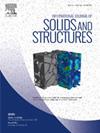考虑粘塑性和界面损伤的碳纳米管涂层模糊纤维复合材料分层细观力学建模
IF 3.4
3区 工程技术
Q1 MECHANICS
International Journal of Solids and Structures
Pub Date : 2025-05-08
DOI:10.1016/j.ijsolstr.2025.113409
引用次数: 0
摘要
本研究研究了模糊纤维复合材料,其特点是粘塑性基体和模糊纤维,即涂有径向排列的碳纳米管(CNTs)的纤维。开发了一个全面的微力学框架来模拟和优化这些复合材料,特别强调通过模糊纤维和基体之间区域的微孔生长引入的界面损伤机制。通过建立等效光纤模型,有效地降低了多相结构的复杂性,便于高效的参数分析。采用复合圆柱体组合(CCA)、转化场分析(TFA)和周期性均质技术,预测等效纤维法和全模糊纤维复合材料的整体应力应变响应。框架和模型参数的识别使参数/灵敏度分析能够研究不同关键参数(包括体积分数)的影响。本文的研究结果有助于加深对单向模糊纤维复合材料的理解,并为今后考虑非线性机制的参数化研究和模糊纤维复合材料的应用奠定基础。本文章由计算机程序翻译,如有差异,请以英文原文为准。

Hierarchical micromechanical modeling for CNT-coated fuzzy fiber composites accounting for viscoplasticity and interfacial damage
This study investigates fuzzy fiber composites, characterized by a viscoplastic matrix and fuzzy fibers, i.e. fibers coated with radially aligned carbon nanotubes (CNTs). A comprehensive micromechanical framework is developed to model and optimize these composites, with a particular emphasis on interfacial damage mechanisms introduced through microvoids growth in the region between the fuzzy fibers and the matrix. By developing an equivalent fiber model, the complexity of the multi-phase structure is effectively reduced, facilitating efficient parametric analyses. Various homogenization techniques, including Composite Cylinder Assemblage (CCA), Transformation Field Analysis (TFA), and periodic homogenization, are combined to predict the overall stress–strain responses of the equivalent fiber approach and then the full fuzzy fiber composite. The identification of the framework and model parameters enabled a parametric/sensitivity analysis to study the effect of varying key parameters, including the volume fraction. The results of this paper contribute to a deeper understanding of unidirectional fuzzy fiber composites and establish a foundation for future parametric investigations and fuzzy fiber composite applications accounting for nonlinear regimes.
求助全文
通过发布文献求助,成功后即可免费获取论文全文。
去求助
来源期刊
CiteScore
6.70
自引率
8.30%
发文量
405
审稿时长
70 days
期刊介绍:
The International Journal of Solids and Structures has as its objective the publication and dissemination of original research in Mechanics of Solids and Structures as a field of Applied Science and Engineering. It fosters thus the exchange of ideas among workers in different parts of the world and also among workers who emphasize different aspects of the foundations and applications of the field.
Standing as it does at the cross-roads of Materials Science, Life Sciences, Mathematics, Physics and Engineering Design, the Mechanics of Solids and Structures is experiencing considerable growth as a result of recent technological advances. The Journal, by providing an international medium of communication, is encouraging this growth and is encompassing all aspects of the field from the more classical problems of structural analysis to mechanics of solids continually interacting with other media and including fracture, flow, wave propagation, heat transfer, thermal effects in solids, optimum design methods, model analysis, structural topology and numerical techniques. Interest extends to both inorganic and organic solids and structures.

 求助内容:
求助内容: 应助结果提醒方式:
应助结果提醒方式:


